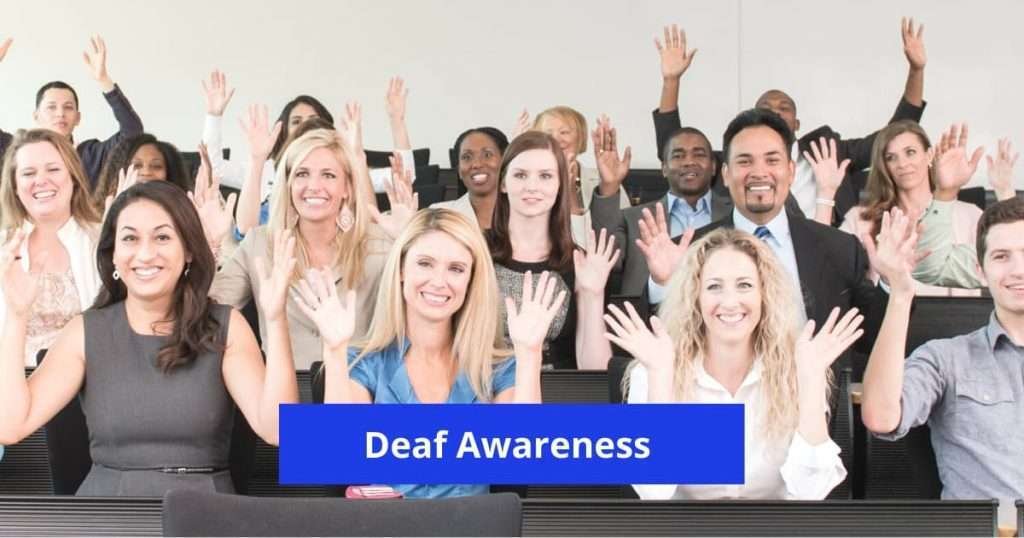Deaf Awareness training is essential for all public-facing businesses as hearing loss is more common than you think. Current estimates suggest there are over 11 million people with some form of hearing loss and over 150,000 profoundly deaf people who use sign language. The world is becoming more and more accessible to customers with disabilities so it’s important that you’re accessible to deaf customers too.
Deaf awareness is important to you, your customers and your staff. Did you know 70% of customers with hearing loss do not re-visit businesses that are not deaf aware? Employees that are not trained on how to adapt their communication methods or who don’t know when a sign language interpreter is necessary can really hurt your business. Can you afford to lose repeat business?
Did you also know that over 56% of staff with hearing loss suffer some form of discrimination? As many as 1 in 4 deaf employees quit their jobs due to a lack of support. So, bad experiences mean you could also lose valuable staff as well as customers.
By training staff to be deaf aware, you can avoid costly recruitment costs and widen your customer base at the same time.
Deaf people who use sign language face the most barriers in society. Part of the issue is a communication barrier – having limited access because a certain level of English is used (and expected) can make services inaccessible. Other factors such as attitudinal, cultural, technological barriers can affect the accessibility of your organisation.
What’s Covered In Deaf Awareness Training?
The courses are usually aimed at anyone who interacts with the public. Like everyone else, a deaf customer’s buying experience is important.
Deaf Awareness courses usually cover:
- The Equality Act and what ‘reasonable adjustments’ make deaf and hard of hearing people feel welcome.
- Lip- reading and how effective it really is for giving information
- Guidance on effective communication strategies
- Provide information on commonly used communication aids from Video relay services to apps available on mobiles.
Course Structure:
Typically, courses are usually offered in one of three formats: self-guided learning online, webinar sessions or face to face sessions where a tutor or specialist will visit your place of work.
The courses we list below may have interviews with deaf and hard of hearing people to help you understand the customer experience from a deaf perspective. This is really useful for you as an organisation as you learn from direct customer experience. Some courses also cover working with deaf staff.
This type of training can improve the productivity and confidence of your staff. Good communication skills are vital for reducing barriers particularly when there are cultural, linguistic differences.
Learning Outcomes
By the end of your Deaf Awareness training you should:
- Understand the importance of equal access to those who are Deaf or hard-of-hearing
- Be confident with applying effective communication tactics
- Know about assistive technologies and support available
- Learn basic greetings in British Sign Language, such as hello, thank you, how are you, my name is
Most courses do not expect you to know anything about deafness or deaf people before starting a course.
Communication Tips
So how can you improve your communication and make your business more accessible generally? Below are some quick tips to improve communication with Deaf and Hard of Hearing people:
- Make sure you offer a number of different ways for people to contact you e.g. online booking appointments system, email booking/confirmation system. You might also include a text messaging service.
- Have a deaf awareness session. Knowledge is power and can empower staff to feel more confident around those that communicate differently.
- If a BSL interpreter is preferred, arrange for a qualified interpreter to attend the next meeting. There is a public register of BSL interpreters on the NRCPD website.
- Ensure you have a system in place for booking an interpreter and that staff know the booking process.
- Are there visual alerts in waiting areas? Alternatively, make sure staff meet the customer in person and use the relevant communication tactics to make your customer feel welcome and understood.
- Never say ‘it doesn’t matter’ if the person did not understand you the first or second time you say something. Re-phrase information or use visuals to convey your message.
Deaf Awareness week:
There are lots of video clips on YouTube that will help you understand the world from a deaf perspective. There is also Deaf Awareness week when the issues around deafness are highlighted:
Deaf Awareness training can enhance your customer offer and is a great way to support your staff to make deaf customers feel welcome. Check out our list of training providers below:
Royal Association for Deaf People (RAD)
bslcourses.co.uk online only
Deaf Aware (Signature) online only
In Scotland, educators can access a BSL toolkit which provides information on how best to support deaf children. The toolkit includes information on BSL, Deaf identity and Deaf culture.
Other services that provide BSL resources include the British Deaf Association (BDA) who also provide information about Deaf culture and the Deaf community.
Other resources:
Related articles:

